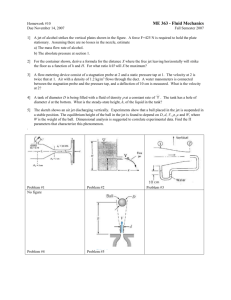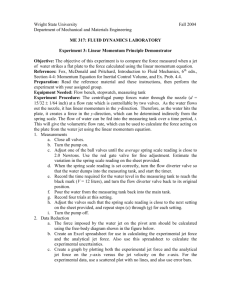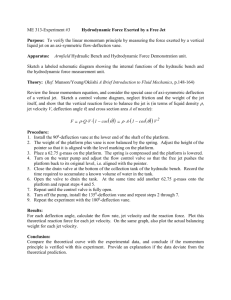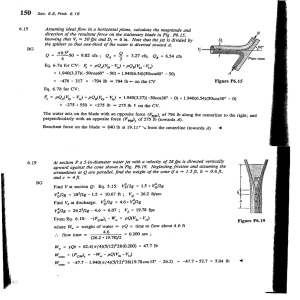1 LDA application and the dual-measurement-method in experimental investigations
advertisement
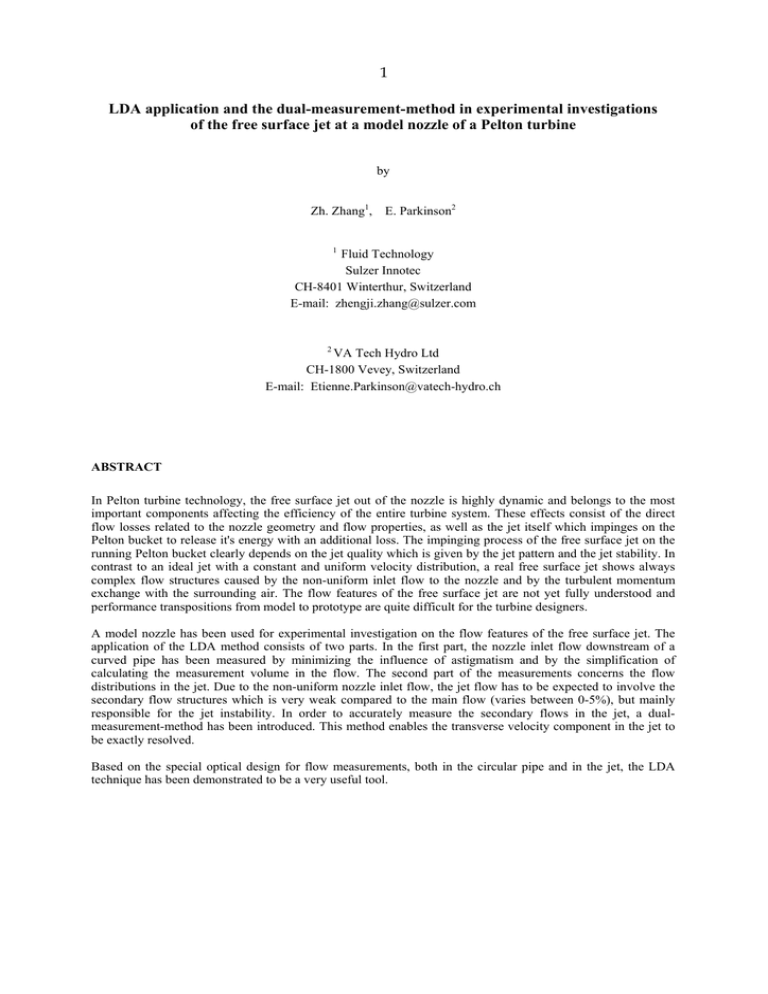
1 LDA application and the dual-measurement-method in experimental investigations of the free surface jet at a model nozzle of a Pelton turbine by Zh. Zhang1, E. Parkinson2 1 Fluid Technology Sulzer Innotec CH-8401 Winterthur, Switzerland E-mail: zhengji.zhang@sulzer.com 2 VA Tech Hydro Ltd CH-1800 Vevey, Switzerland E-mail: Etienne.Parkinson@vatech-hydro.ch ABSTRACT In Pelton turbine technology, the free surface jet out of the nozzle is highly dynamic and belongs to the most important components affecting the efficiency of the entire turbine system. These effects consist of the direct flow losses related to the nozzle geometry and flow properties, as well as the jet itself which impinges on the Pelton bucket to release it's energy with an additional loss. The impinging process of the free surface jet on the running Pelton bucket clearly depends on the jet quality which is given by the jet pattern and the jet stability. In contrast to an ideal jet with a constant and uniform velocity distribution, a real free surface jet shows always complex flow structures caused by the non-uniform inlet flow to the nozzle and by the turbulent momentum exchange with the surrounding air. The flow features of the free surface jet are not yet fully understood and performance transpositions from model to prototype are quite difficult for the turbine designers. A model nozzle has been used for experimental investigation on the flow features of the free surface jet. The application of the LDA method consists of two parts. In the first part, the nozzle inlet flow downstream of a curved pipe has been measured by minimizing the influence of astigmatism and by the simplification of calculating the measurement volume in the flow. The second part of the measurements concerns the flow distributions in the jet. Due to the non-uniform nozzle inlet flow, the jet flow has to be expected to involve the secondary flow structures which is very weak compared to the main flow (varies between 0-5%), but mainly responsible for the jet instability. In order to accurately measure the secondary flows in the jet, a dualmeasurement-method has been introduced. This method enables the transverse velocity component in the jet to be exactly resolved. Based on the special optical design for flow measurements, both in the circular pipe and in the jet, the LDA technique has been demonstrated to be a very useful tool. 2 1. INTRODUCTION The free surface jet flow out of the nozzle of a Pelton turbine is highly dynamic and belongs to the most important components affecting the efficiency of the entire turbine system. The jet quality is associated with the jet pattern and the jet stability. While an ideal jet is assumed to have a constant and uniform velocity distribution in the jet cross-section and possesses no secondary flow, a real free surface jet shows always the complex flow structures caused by the non-uniform inlet flow to the nozzle and by the turbulent momentum exchange with the surrounding air. These realities of the free surface jet clearly affect the jet impinging process on the Pelton bucket. Investigations on the free surface jet in the Pelton turbine technology were since long time mostly restricted to the use of Pitot tube for the flow distribution measurements and to the photographical method for the flow visualisations. Such methods, however, are insufficient when dealing with small-scale disturbances in the jet where the ratio between transversal and axial velocities is considerably undersized. The use of Pitot tubes, for instance, assumes a constant static pressure in the jet. The assumption is only true if the flow downstream of the jet-contracted section is measured. As the numerical method has become to be a useful tool in solving the flow problems, it has also been applied to the free surface jet in Pelton turbine technology (Parkinson et al. 1998; Nonoshita et al. 1994; Berntsen et al. 2001). Since the free surface jet with involved secondary flow structures embodies the complex flow behaviour, the experimental determination of such flows remains indispensable. The first application of the modern laser method for quantitative and accurate measurements of the free surface jet was conducted and extended by Zhang et al. (2000a, 2000b, 2001). By ensuring the laser beam to be transmitted through the rough and wavy jet surface the Laser Doppler Anemometry (LDA) has been demonstrated to be a very successful tool for such flow measurements. The measurement results were also used, as the numerical simulation of the jet flow had to be validated by experiments (Muggli et al. 2000). In the current paper, the advanced LDA method has been adapted for measurements of flows both at the nozzle inlet and in the free surface jet. The former is indeed restricted to a flow downstream of a bend with a circular cross-section. The measurement then suffers from troubles with the laser beam refraction at the pipe surface, so that the velocity signal quality as well as the measurement volume will be affected. The measurement of the flow distribution in the free surface jet belongs to the main part of the present investigation. Due to the nonuniform flow distribution at the nozzle inlet, the secondary flow structure persists in the jet. Even though such a secondary flow is hardly comparable with the main flow, it may considerably affect the jet stability owing to the free surface nature of the jet. On the other side, the very weak secondary flow against the main flow (in the order of 0~0.05) provides the difficulty to be accurately resolved. In this paper, a method will be demonstrated which enables the secondary flow structures to be exactly resolved. This method is known as the dualmeasurement-method. 2. EXPERIMENTAL METHODS 2.1 TEST FACILITY A model nozzle from VA TECH HYDRO has been used to generate the free surface jet. The nozzle exit diameter is D0=36.65 mm. To approximate the real flow conditions as those at the Pelton turbines, the nozzle is connected to a bend that in turn is connected to a long straight pipe (Fig. 1). The experimental facility enables a net hydraulic head of up to 30 m and a flow rate of 1000 l/min to be achieved. A short pipe between the bend and the nozzle is made of Plexiglas to ensure the optical access to the flow at the nozzle inlet. In order to perform LDA measurements at different distances to the nozzle exit as well as from different azimuths around the nozzle axis, a traversing system was established to support the LDA optics. transparent pipe model nozzle LDA jet Fig. 1: Test facility and the support system for LDA optics 3 2.2 LDA-METHOD 2.2.1 Flow measurement in the circular tube at the nozzle inlet The purpose of this measurement is to characterize the inlet flow condition, which is remarkably affected by the bend and is responsible, according to the observation, for the instability of the free surface jet. In order to get a clear flow pattern downstream of the bend, at least both the axial and tangential velocity components have to be resolved. Flow measurements in the circular pipe by means of LDA method can be considerably improved in the way that the outside of the pipe is cut off to be plane. This performance is initially conducted to compensate for the effect of astigmatism, which is associated with the off-axis alignment of LDA (Zhang and Eisele 1995, 1996) or with the curved interface. It contributes additionally to the simplification in calculating the measurement volume in the flow, because the undesirable laser beam refraction at the curved interface merely remains at the inside of the pipe. Measurements of the axial velocity component are not affected by the laser beam refraction on the internal wall of the circular pipe. Under the condition that the plane containing two available laser beams remains parallel to the pipe axis, the crossing angle between two refracted laser beams remains constant, even if the laser beams do not cross the pipe axis. For measuring the tangential velocity component, however, there are two aspects to be considered: 1) the shift of the measurement volume in the flow is not proportional to the shift of LDA optics; 2) the crossing angle between two refracted laser beams and thus the property of the measurement volume depend on the local position of the measurement volume in the flow. Although there are simplified calculation processes generalized for circular pipes (Boadway and Karahan 1981), they are, however, not available for the case with a plane cutoff at the outside of the pipe. The accessible calculation for the present case is described in following. The laser beams are considered as they are present in the transparent pipe wall (index 1). Owing to the symmetrical condition between two laser beams, only one beam will be considered here. The measurement volume is then formed on the symmetrical axis (x-axis in Fig. 2) where the laser beam arrives. The laser beam is assumed to have its start position 1 at which the measurement volume is positioned at the internal side of the pipe. The shift of the laser beam to the position 2 is given by a distance s1x that is about n1 -times of the movement of LDA optics in the air. The measurement volume is moved to the position m , while the virtual measurement volume is found at m′ . The application of the sine law to the triangles ocm ′ and ocm , respectively, yields R − s1x R = sin (α 1 − ϕ ) sin α 1 (1) R − s2x R = sin (α 2 − ϕ ) sin α 2 (2) The refraction law in such a case is given by: n1 sin (α 1 − ϕ ) = n 2 sin (α 2 − ϕ ) 1 s1x 2 α1 (3) n2 n1 y R c α2 s2x s1x x m m’ ϕ o Fig. 2: Method to determine the measurement volume in circular tube 4 These three equations form the basic solutions for both the position ( s 2 x ) and the properties ( 2α 2 ) of the measurement volume in the flow. For a given movement of LDA optics s1x the following calculating process can be performed: (1) (3 ) (2 ) s1x → ϕ → α 2 → s2x (4) Finally, it yields from Eqs. (1), (2) and (3): sin α1 n1 R − s 2 x = sin α 2 n 2 R − s1x (5) This equation represents just the ratio of the fringe spacing in the measurement volume to that in the measurement volume, which is formed when the laser beams are refracted on the plane interface. It can be used therefore as a factor for correcting the measurement results. In the present measurement, a piece of plexiglas was used to get a plane cut-off at the outside of the pipe, as shown in Fig. 3a. As a result of minimizing the astigmatism effect by this way it becomes reliable to get the sufficient burst signals (data rate) even at a depth of about 2/3 of the pipe diameter. In contrast, it would be fairly limited within 1/3 of the pipe diameter, if no accessory of Plexiglas would be used. To get the complete flow distribution across the pipe, the measurement then has also to be performed from the opposite side by rotating the LDA optics 180° around the nozzle axis. This can be easily achieved by means of the optical support system shown in Fig. 1. Due to astigmatism, only one-component measurement is possible. The measurement results are shown in section 3.1. (a) Fig. 3: LDA arrangement (a) for flow measurements in the circular pipe (b) for jet flow measurements 2.2.2 (b) LDA Jet measurements The jet in the present investigation is not transparent due to the flow turbulence at the jet surface. To ensure the laser beams to transmit through the rough and wavy jet surface a wedge of plexiglas according to Fig. 3b was used, as this was demonstrated to be very effective for LDA measurements (Zhang et al. 2000a, 2000b). The disturbance on the flow is restricted within a thin layer of maximal 0.1 mm, if the flow on the wedge is considered to be comparable with the boundary layer along a plane plate. Due to the use of the plane wedge the data rate of LDA measurements nearby remains constant through the whole jet thickness. 2.2.3 LDA system The LDA system used in the current investigations is a two-component system from Dantec Measurement Technology. To get a high spatial resolution in measurements of velocity profiles, the LDA has been configured to have a beam-crossing angle equal to 13.54°. 2.3 DUAL-MEASUREMENT-MOTHOD The non-uniform flow distribution at the nozzle inlet has the consequence that secondary flow structures appear in the jet. Although such a secondary flow is hardly comparable in order of magnitude with the main flow, it may considerably affect the jet stability owing to the free surface nature of the jet. The jet instability at the 5 present nozzle connected to the bend is evident if compared with the jet out of the nozzle with straight inlet flow. The difficulty in accurately measuring the secondary flow in the jet obviously arises from the circumstance that the corresponding velocity component u t is much smaller against the velocity component of the main flow u z (within 0~0.05). The measurement of the tangential velocity component is thus very sensible against the inaccuracy in the optical alignment. Only by knowing such an error in the LDA alignment, the error involved in the velocity components can be corrected subsequently. For this purpose a dual measurement method has been developed, which is based on two separate LDA measurements. The method enables the error in the optical alignment to be exactly determined, as described below. To resolve the distribution of the tangential velocity component along a straight line through the jet thickness, the straight line is traversed in sequence from both ends of the line by turning the optical support by 180 degrees according to Fig. 1. Since the positive senses of the tangential component measured by v1 and v 2 , respectively, lie on both sides of the traversing line, both measurements have to be distributed as reflected by each other (Fig. 4a). The value v sh as a velocity shift straightforwardly indicates the error in LDA alignment. An inclination angle τ in the LDA alignment according to the sketch in Fig. 4 is determined by tan τ = v sh u with u as another LDA-component. The actual tangential component in the jet is then calculated to: u t = v1,2 ⋅ cos τ − u ⋅ sin τ (6) Or for τ << 1 u t = v1,2 − v sh (7) For a negative velocity shift ( v sh < 0 ) there is correspondingly τ < 0 . The positive sense of u t is identical with that of v1 or v 2 , depends on which is used in the above equations. ut τ v (m/s) v 1 0.5 (a) 0 rschiebung Vshift vsh=0.4 vsh =0.4 -0.5 -1 -0.8 u 1 Fig. 4: Dual-measurement-method to estimate the real tangential velocity component in the jet flow v (m/s) uz 0.5 -0.4 0 0.4 0.8 corrected korregiert (b) 0 -0.5 -1 -0.8 -0.4 0 r/Ro 0.4 0.8 As can be seen from Eq. (6), the velocity shift v sh caused by τ ≠ 0 may be very large due to the large value of u . It may be of the same extent as the existent component u t to be measured. From Fig. 4a, which is obtained from a real measurement, a velocity shift of 0.4 m/s can be read out. This velocity shift corresponds to an optical alignment error by τ = 0.91° . The actual tangential component, after being corrected according to Eq. (6), has been shown in Fig. 4b for comparison. This final result can be considered to be exactly accurate. 6 3. MEASUREMENT RESULTS 3.1 NOZZLE INLET FLOW (DOWNSTEAM OF THE BEND) The flow at the nozzle inlet is influenced by the bend and thus possesses the complex flow structure. Both axial and tangential velocity components were measured by concerning the optical condition given in section 2.2 and are shown in Fig. 5. The velocity deficit in the core of the flow results from the elliptic influence of the “torpedo” in the nozzle. The distribution of the tangential component shows the secondary flow structure consisting of two parts of rotational flows. As will be shown, such rotational flows remain along the jet flow. 1.4 (b) (a) Uz/Uo 1.2 measurement 1.0 0.2 m/s 0.8 0.6 a-a a b-b 0.4 -1 -0.5 0 0.5 b 1 b r/R a Fig 5: Velocity distribution downstream of the bend. (a) Axial velocity component, (b) tangential velocity component 3.2 FLOW DISTRIBUTION IN THE JET Among a series of flow measurements, an example will be presented here for a net hydraulic head H = 30 m , as shown in Fig. 6. The measurements were taken at a distance z = 0.8D0 to the nozzle exit, with D0 as the nozzle diameter. Both the velocities and the radial coordinates are normalized, respectively, by u 0 = 2 gH and R0 = D0 2 . The tangential components were obtained by the dual measurement method described in section 2.3. 1.00 J J G GG Uz/Uzo 0.95 JG JG JG J JG JG JG JG G J 0.90 0.85 G a-a J b-b GG J J J JG JG JGG JG JG JG JG G (b) (a) G measurement JG GJ J J J GG J 0.80 -0.7 -0.5 -0.3 -0.1 0.1 r/R 1 m/s a b 0.3 0.5 0.7 b a Fig. 6: Velocity distribution in the jet for a hydraulic head H=30 m (a) Axial velocity component, (b) tangential velocity component The velocity deficit in the jet core is the wake of the needle surface. Out of the jet core the likely linear variation in the axial component towards the jet surface has been observed. Such a velocity distribution precisely points out that at the current jet section, z = 0.8D0 the streamlines are still curved and the jet-contracted section (jet waist) has not been arrived. As indicated by Zhang et al. (2000a, 2000b), this type of velocity distribution cannot be resolved by conventional methods such as the Pitot tube. By the way, from this linear velocity distribution the real jet waist downstream can be estimated (Zhang 2000). 7 Strähne The secondary flow in the jet (Fig. 6b) is identified to be coherent with the secondary flow at the nozzle inlet. In the near zone at the jet surface, i.e. on the right side of the traversing line b-b, two parts of secondary flows are coming together. This flow behaviour straightforwardly leads to a well-visible and stable disturbance on the jet surface, as shown in Fig. 7. 4. CONCLUSION Fig. 7: In measurements of flow distributions both in the Disturbance on the jet surface circular pipe downstream of a bend and in the owing to the secondary flow in free surface jet existing a model nozzle, the LDA the jet method has been demonstrated to be very efficient and shows great advantages compared to other conventional methods. For flows in the pipe of a circular cross section, the success of measurements is based on the minimization of astigmatism effect and the simplification of calculations of the measurement volume in the flow. In measurements of flow distribution in the free surface jet, a dual measurement method has been introduced, with which even the smallest secondary flow velocities in the jet can be accurately resolved. The measurement results have been used to reveal some special phenomena with respects to the flow stability and quality of the free surface jet. They are also used to successfully validate the numerical simulations. REFERENCES Berntsen G, Brekke H, Haugen J, Risberg S (2001): Analysis of the free surface non-stationary flow in a Pelton turbine. Hydro 2001, Opportunities and Challenges, Riva del Garda, Italy Boadway J, Karahan E (1981): Correction of Laser Doppler Anemometer readings for refraction at cylindrical interfaces. DISA Information No. 26, pp 4-6 Muggli F, Zhang Zh, Schärer C, Geppert L (2000): Numerical and experimental analy-sisof Pelton turbine flow, Part 2: The free surface jet flow. 20th IAHR Symposium, Charlotte, NC, USA Nonoshita T, Matsumoto Y, Kubota T, Ohashi H (1994): Numerical simulation of jet in a Pelton turbine. Proc. 17th IAHR Symposium, Beijing, China Parkinson E, Lestriez R, Chapuis L (1998): Flow calculations in Pelton turbines – Part 1: Repartitor and injector numerical analysis. Proc. 19th IAHR Symposium, Singapore Zhang Zh Eisele K (1995): Off-axis alignment of an LDA-probe and the effect of astigmatism on the measurements. Experiments in Fluids 19: 89-94 Zhang Zh, Eisele K (1996): The effect of astigmatism due to beam refractions in the formation of the measurement volume in LDA measurements. Experiments in Fluids 20: 466-471 Zhang Zh (2000): Experimentelle Untersuchungen am Freistrahl mit der Peltondüse Jn 1012. Interne Bericht: STT-TB00_019 Zhang Zh, Muggli F, Parkinson E, Schärer C (2000a): Experimental investigation of a low head jet flow at a model nozzle of a Pelton turbine, 11. Int. Seminar on Hydro Power Plants, Vienna University of Technology Zhang Zh, Eisele K, Geppert L (2000b): Untersuchungen am Freistrahl aus einer Modell-düse von PeltonTurbinen mittels LDA. GALA-Tagung, München/Freising Zhang Zh, Parkinson E (2001): Strömungsuntersuchungen am Freistrahl der Pelton-Turbine und Anpassen des LDA-Verfahrens, GALA-Tagung, Winterthur/Schweiz


